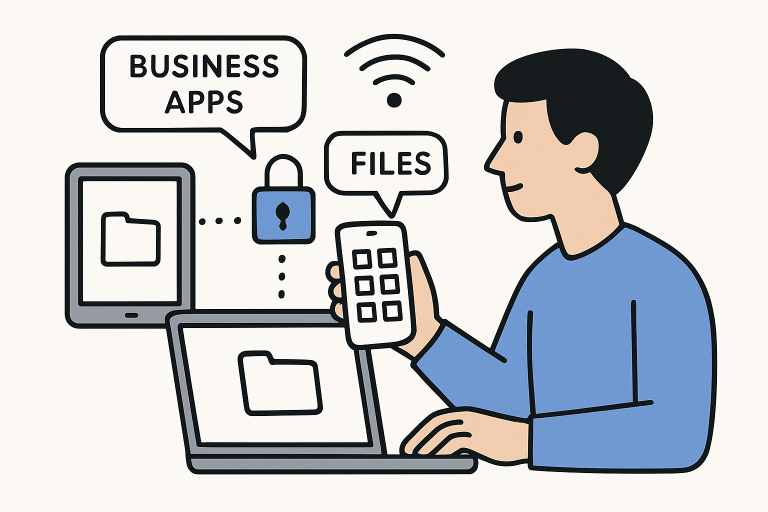Business
How Enterprise Mobility Management Drives Productivity

Key Takeaways
- EMM facilitates seamless access to corporate resources, boosting employee efficiency.
- Enhanced security measures protect sensitive data, fostering trust and compliance.
- Automation within EMM reduces manual IT tasks, allowing focus on strategic initiatives.
- Data-driven insights from EMM inform better decision-making and operational improvements.
Enterprises are grappling with the increasing decentralization of their workforces, requiring robust strategies to protect data, safeguard operations, and keep teams connected. Enterprise Mobility Management (EMM) offers a centralized framework for managing mobile devices, apps, and corporate data, allowing employees to work more flexibly. EMM provides tools and policies to ensure secure access to critical company resources, enhancing productivity by streamlining device management, fortifying defenses against unauthorized access, and optimizing workflows. As the digital workspace evolves, EMM is crucial for companies to maintain a competitive edge and adapt to new business demands.
Seamless Access to Corporate Resources
One of EMM’s primary advantages is enabling employees to securely access business applications, files, and communication platforms from any device or location. This flexibility breaks down traditional barriers to productivity, granting team members the freedom to contribute and collaborate outside the confines of the office. Research by The Economist Intelligence Unit points out that organizations excelling at mobile technology adoption experience a 16% increase in workforce productivity compared to their less agile counterparts.
By centralizing identity management and resource provisioning, enterprise mobility solutions make it simple for IT teams to onboard new users, provide or revoke access, and push app updates over-the-air—streamlining daily operations and reducing bottlenecks.

Enhanced Security Measures
Security concerns are at the forefront of enterprise mobility, especially as BYOD (Bring Your Own Device) policies proliferate. EMM solutions address these challenges head-on through device encryption, remote wipe, and multi-factor authentication. According to a report by Samsung, more than half of organizations using EMM have seen visible improvements in security outcomes, with over 90% expressing confidence in their company’s approach to securing devices. With granular policy controls, administrators can enforce compliance according to industry regulations and adapt quickly to evolving threat landscapes, all while supporting diverse device ecosystems.
Automation Reduces Manual Tasks
Today’s EMM platforms utilize automation to minimize routine IT overhead. Software patching, app deployments, device provisioning, and compliance checks are handled automatically, reducing IT staff’s time resolving mundane issues and enabling them to focus on strategic projects. Automated alerting and remediation also help organizations respond to security incidents faster, mitigating risks before they impact business operations.
Data-Driven Decision Making
Comprehensive analytics are a core function of advanced EMM solutions. By gathering data on device usage, access patterns, and security events, EMM platforms enable IT and operations leaders to make informed, timely decisions. These insights can reveal process inefficiencies, highlight application adoption rates, and identify potential vulnerabilities so businesses can proactively fine-tune their mobile environments. Data-driven decision-making remains a competitive necessity in adapting to rapidly changing market conditions.
Improved Collaboration and Communication
With EMM, employees remain connected to corporate communication and collaboration platforms regardless of location. These solutions ensure seamless file sharing, protected messaging, and team coordination, enabling projects to move forward without disruption. For example, real-time document sharing and remote access to project management tools empower teams to communicate and collaborate productively, fostering a culture of agility and innovation even when teams are distributed across geographies.
Cost Efficiency
Adopting EMM not only secures mobile operations but also delivers significant cost savings. Remote management capabilities reduce the need for on-site technical support, lowering maintenance expenses. These savings are especially impactful for companies that support large-scale BYOD programs, as securing employee-owned devices becomes streamlined and hardware outlays are reduced.
Scalability and Flexibility
EMM solutions are designed to scale with organizational needs, accommodating fluctuating device inventories and user bases with minimal disruption. Whether onboarding new hires or expanding to new markets, EMM platforms equip businesses to respond efficiently to growth. This capability is vital in today’s business landscape, where adaptability is synonymous with success, and the ability to scale operations securely can make or break new initiatives.
Compliance and Regulatory Adherence
With ever-increasing regulatory scrutiny surrounding data privacy and protection, EMM plays a pivotal role in ensuring that organizations stay compliant. These systems enforce corporate security policies, maintain detailed audit logs, and monitor device compliance, significantly reducing the risk of regulatory breaches and associated penalties. This capability is essential in regulated industries such as finance, healthcare, and government services, where the cost of non-compliance can be devastating.
Integrating an enterprise mobility strategy is fundamental to success in a mobile-first business world. EMM delivers the security, flexibility, and control companies need—empowering teams to work productively and securely, wherever business takes them.
